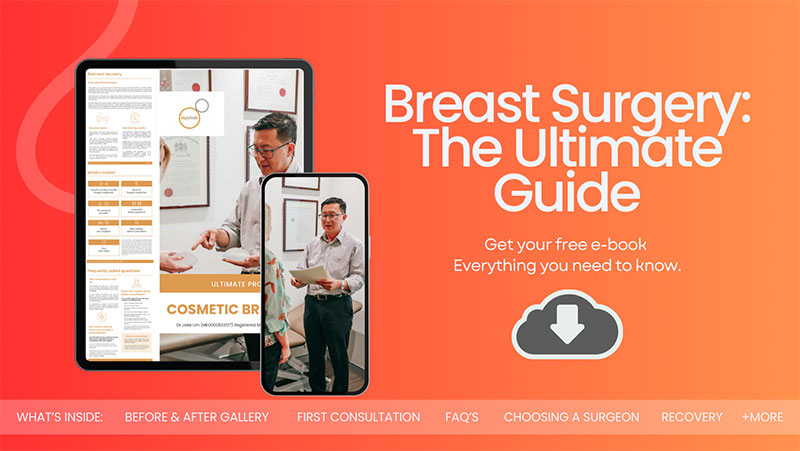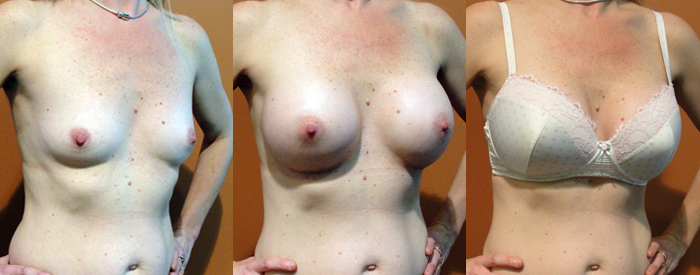Important Considerations before Undergoing a Breast Augmentation Surgery
Embarking on the journey of altering one’s body through breast augmentation can be an exhilarating yet daunting venture. Many individuals find themselves contemplating this plastic surgery procedure. However, as one navigates through the maze of pre-surgery consultations to the post-op recovery, there may arise facets of this journey that remain unanticipated. This blog aims to encapsulate the essence of those experiences, shedding light on the unforeseen aspects of breast augmentation surgery.
In this blog, Sydney Plastic Surgeon Dr Jake Lim’s goal is to provide a realistic glimpse into the process, aspiring to better equip those considering breast augmentation surgery with insights that can prepare them for what lies ahead.
Dr Lim’s 2024 Breast Surgery Guide

What to Keep in Mind before Breast Augmentation Surgery
1. Managing expectations better regarding the size and appearance of the breasts post-op is important.
One of the primary steps towards a satisfying breast augmentation experience is to manage expectations effectively, especially regarding the size and appearance of the breasts post-op. Individuals often have a desired outcome in mind, fuelled by inspirational images on social media or a desire to regain pre-pregnancy aesthetics. However, it’s vital to understand that each body reacts to surgery differently. The same implant size can look different on various body types, and factors such as natural breast tissue, chest wall shape, and skin elasticity play significant roles in the final appearance. Moreover, swelling post-surgery can temporarily alter the appearance, requiring patience as the body heals and the true results unveil gradually. A well-informed expectation, guided by professional medical advice, can significantly enhance satisfaction with the surgical outcome.
2. A skilled surgeon can significantly impact the outcome.
The expertise of the plastic surgeon is a cornerstone of a successful breast augmentation procedure. A skilled plastic surgeon, certified by reputable boards and backed by a wealth of experience, can provide not only a safe surgical environment but also an aesthetically pleasing result. Their nuanced understanding of breast anatomy, proficiency in surgical techniques, and ability to guide patients in making informed decisions are invaluable. The rapport between the patient and the plastic surgeon, characterised by open communication and trust, further enriches the surgical experience. It’s important to invest time in researching, consulting multiple surgeons, and reviewing before-and-after photos to gauge a surgeon’s expertise and aesthetic style.

3. The cost of the procedure can be higher than anticipated.
The cost of breast augmentation can indeed be a sticker shock for many. While initial research might provide a ballpark figure, the total expense can escalate with unforeseen costs. The procedure’s cost isn’t confined to just the plastic surgeon’s fee; it encompasses the cost of implants, anaesthesia, operating room facilities, medical tests, post-surgery garments, and follow-up appointments. Moreover, geographical location and the plastic surgeon’s experience significantly impact the total cost. Unanticipated expenses, such as additional corrective surgeries or treatments for complications, can also add to the financial burden. Hence, a comprehensive financial plan, including a contingency fund for unexpected expenses, is advisable for a smooth surgical journey devoid of financial stress.
4. The recovery timeline can vary.
The recovery timeline post-breast augmentation can significantly vary from one individual to another, influenced by several factors including the surgical technique employed, the individual’s overall health status, and the body’s innate healing capacity. While some may bounce back within a few weeks, others might take a few months to fully recover. The initial healing phase, characterised by swelling, bruising, and restricted mobility, is followed by a longer-term recovery where the implants settle into their position, and the scars mature. Understanding that the journey to full recovery can take time, and being prepared for a potentially longer recovery period can alleviate anxiety and contribute to a smoother recovery experience.
5. Aftercare is just as important as the surgery itself.
Aftercare is an indispensable aspect of the breast augmentation journey, having a profound impact on surgical outcomes. Adherence to the plastic surgeon’s post-operative instructions, including wound care, medication management, and activity restrictions, is paramount. Routine follow-up appointments are crucial to monitor the healing process, identify any complications early, and ensure that the recovery is on the right track. Moreover, wearing the recommended support garments, practicing gentle exercises as advised, and maintaining a nutritious diet can significantly enhance the healing process. The aftercare phase is as critical as the surgery itself, with a diligent aftercare regimen being pivotal in achieving the desired aesthetic and functional outcomes.
6. The level of discomfort can vary too.
The level of discomfort experienced post-surgery is another aspect characterised by individual variability. While some may experience minimal discomfort manageable with over-the-counter analgesics, others might encounter a higher degree of pain necessitating stronger pain relief medications. The surgical technique, the placement of the implants, and individual pain tolerance levels are among the factors influencing the level of post-operative discomfort. Moreover, sensations such as tightness or pressure in the chest area are common as the body adjusts to the new implants. Being mentally prepared for the potential discomfort and having a well-structured pain management plan in place can significantly enhance post-operative comfort levels.
7. Complications can occur.
Like any surgical intervention, breast augmentation carries the risk of complications, both immediate and delayed. Common early complications include infection, haematoma, and seroma formation, while later issues may encompass capsular contracture, implant displacement, or rupture. Furthermore, unsatisfactory aesthetic outcomes like asymmetry or scarring may necessitate revision surgery. It’s vital to have a candid discussion with Dr Jake about the risks and to understand the signs of complications. Early detection and intervention can often mitigate adverse outcomes, underlining the importance of post-operative vigilance and regular follow-up appointments.
8. Breast implants might require replacements in the future.
Breast implants do not have a lifetime guarantee; they are subject to wear and potential failure over time. The average lifespan of implants ranges from 10 to 15 years, although some may last longer, and others might require replacement sooner due to complications or aesthetic dissatisfaction. Implant replacement or removal is a reality that individuals need to anticipate and plan for financially and emotionally. Additionally, evolving personal aesthetic preferences or life changes like pregnancy and weight fluctuations may also prompt a desire for implant revision or replacement.
9. Sensation changes can occur.
A lesser-discussed yet significant aspect of breast augmentation is the potential for altered breast and nipple sensation. The surgical manipulation of breast tissues and nerves can result in temporary or, in some cases, permanent sensory changes. While some individuals experience increased sensitivity, others may face reduced sensation or complete numbness. The extent and duration of sensory changes are unpredictable and can impact personal and intimate experiences. Discussing this reality with Dr Jake pre-operatively and having a supportive environment to navigate these changes post-operatively is crucial.
10. The results of the breast augmentation will change with time.
The perception of ‘permanence’ associated with breast augmentation needs to be revisited to accommodate the dynamic interaction between the augmented breasts and the inexorable changes induced by time. Ageing is a natural process that does not spare any part of the body, including augmented breasts. As years progress, skin elasticity diminishes, and gravitational pull exerts its influence, leading to changes in the appearance of the breasts. They may descend on the chest wall, and the overall breast contour may alter. While implants do not succumb to the sagging associated with natural breast tissue, the surrounding tissue does, and this impacts the overall appearance.
Significant life events such as pregnancy and breastfeeding can profoundly affect the aesthetics of augmented breasts. The hormonal fluxes, the stretching of the skin, and the changes in breast volume during these life phases can alter the shape, size, and position of the implants. Similarly, weight fluctuations can lead to an accumulation or loss of fat in the breast area, impacting the appearance of the augmented breasts.
Given these changes, some individuals might opt for revision surgery to restore or alter the aesthetics of their breasts. This could involve a breast lift, implant replacement, or a change in implant size or type. The prospect of revision surgery underscores the evolving nature of breast augmentation results and the potential need for further surgical interventions.
FAQs about Breast Augmentation Surgery

How do I choose the right plastic surgeon for breast augmentation?
- Selecting a reputable and experienced surgeon is crucial for a successful breast augmentation procedure. Look for board-certified plastic surgeons (FRACS: Fellow of the Royal Australasian College of Surgeons) and review before-and-after photos of their previous procedures. It’s also important to have an in-person consultation to discuss your goals and expectations.
What are the different types of breast implants?
- Breast implants typically come in two types: silicone gel-filled and saline-filled. Silicone implants tend to feel more natural, while saline implants are filled with sterile salt water which is absorbed by the body in case of a leak. Discuss with your plastic surgeon to determine the best choice for your body and desired outcome.
How much does breast augmentation surgery cost?
- The cost of breast augmentation can vary widely depending on the plastic surgeon’s experience, the type of procedure, the geographic location of the practice, and other factors. It’s important to have a clear understanding of all costs involved including surgeon’s fees, hospital or surgical facility costs, anaesthesia fees, and any additional medical expenses.
What is the recovery process like after breast augmentation?
- Recovery from breast augmentation typically involves rest, medication to manage discomfort, and wearing a support bra to minimise swelling. Follow-up appointments with your plastic surgeon are crucial to monitor healing. Full recovery and seeing the final results may take several weeks to months.
Will the results of breast augmentation last permanently?
- While breast implants can last many years, they are not considered lifetime devices. Over time, implants may need to be replaced due to complications or personal choice. Furthermore, natural ageing and life events like pregnancy can affect the appearance of augmented breasts. Discuss the longevity and potential future surgeries with Dr Lim.
Further Reading about Breast Augmentation with Dr Jake Lim
- Read Dr Jake Lim’s Blog about What Cup Size Will I Be after Breast Implant Surgery?
- Read Dr Jake Lim’s Blog about How to Minimise Scars after Breast Augmentation
- Read Dr Jake Lim’s Blog about Breast Implant Options
- Read Dr Jake Lim’s Blog about Factors to Consider When Choosing the Bra after Breast Augmentation
- Read Dr Jake Lim’s Blog about How to Choose the Right Breast Implant Shape
- Read Dr Jake Lim’s Blog about What Can I Do To Optimise My Surgical Results
- Read Dr Jake Lim’s Blog about Waterfall Breast Deformity – Causes and Solutions
- Read Dr Jake Lim’s Blog about Benefits of Mentor Breast Implants
- Read Dr Jake Lim’s Blog about Recovery after Breast Implant Removal
Medical References about Breast Augmentation
- Breast augmentation – Mayo Clinic
- Breast Augmentation – ASPS
- Breast Augmentation: What it is, Types, Surgery & Recovery – Cleveland Clinic




